Basic Introduction of HVAC Air Ceiling Diffusers
- Decades of Expertise: 30 years in the business means unparalleled knowledge and skills in producing top-quality HVAC air ceiling diffusers.
- Advanced Manufacturing: State-of-the-art technology and precise manufacturing techniques ensure each diffuser is of the highest standard.
- Diverse Product Range: Catering to various needs with a wide selection of air ceiling diffusers for different settings and applications.
- Global Reach: Proven success in exporting products worldwide, demonstrating a strong international presence and reliability.
- Innovative Solutions: Continuous investment in innovation to keep products up-to-date with the latest trends and technologies.
- Customer Focus: A deep commitment to customer satisfaction, offering personalized service and products that meet specific client requirements.
Basic styles and sizes of HVAC Air Ceiling Diffusers
HVAC Square and Round Air Ceiling Diffusers
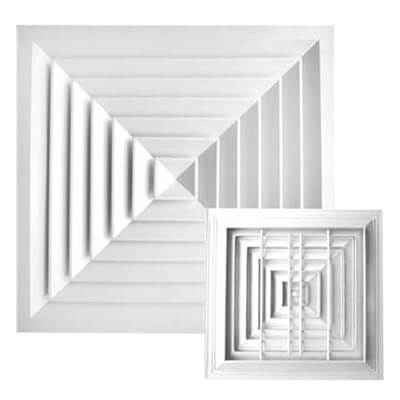 | 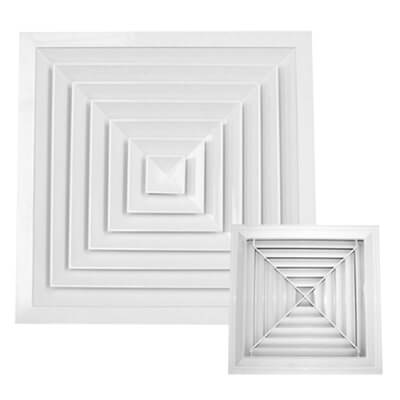 | 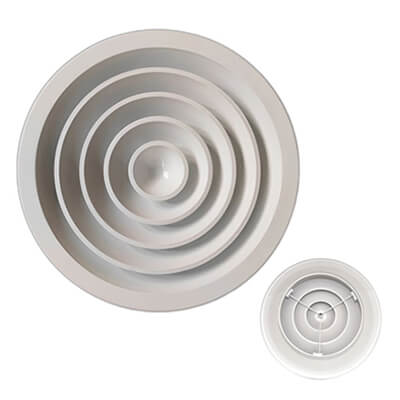 | 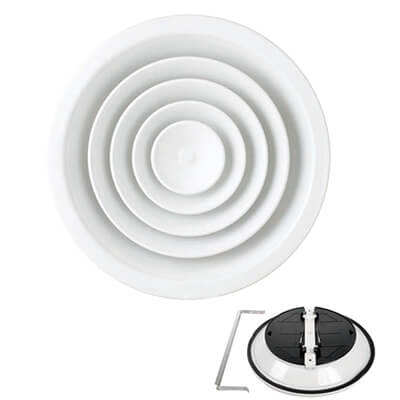 |
| Stamped Type 4-Way diffuser | Welded Type 4-way diffuser | Round Ceiling Diffuser (RCD-A) | Round Ceiling Diffuser (RCD-B) |
Catalog of HVAC Square Air Ceiling Diffusers and Round Air Ceiling Diffusers
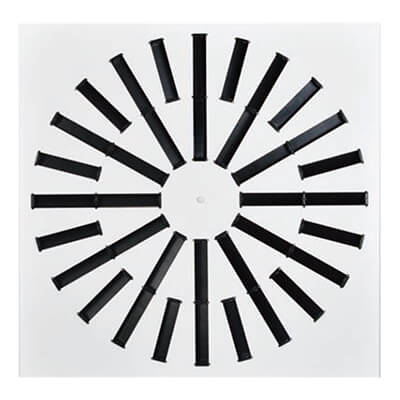 | 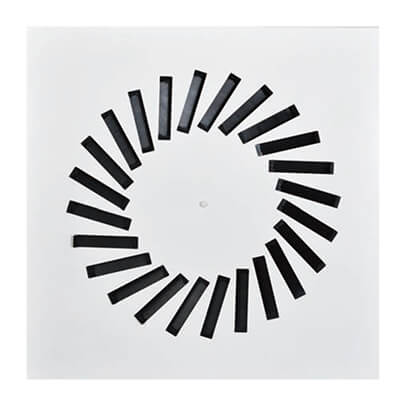 | 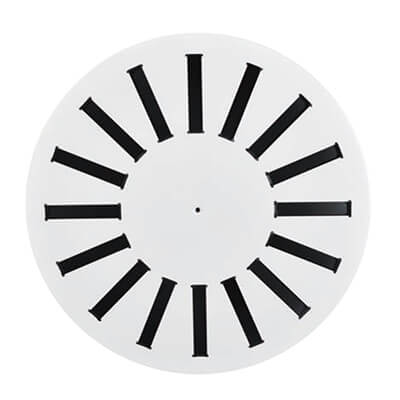 | 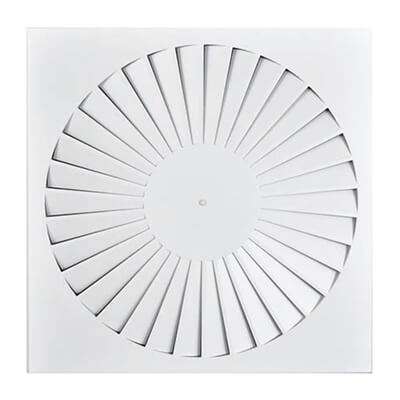 |
| Swirl Diffuser Adjustable Blades | Swirl Diffuser Adjustable Blades | Round Swirl Diffuser | Swirl Diffuser Fixed Blades |
Catalog of HVAC Air Swirl Diffusers
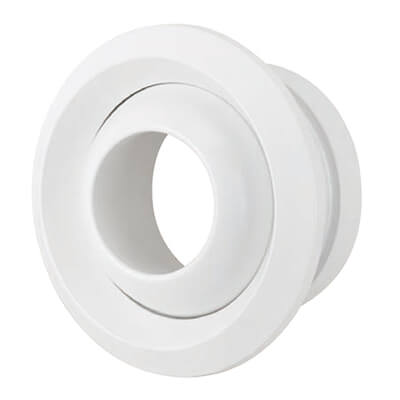 | 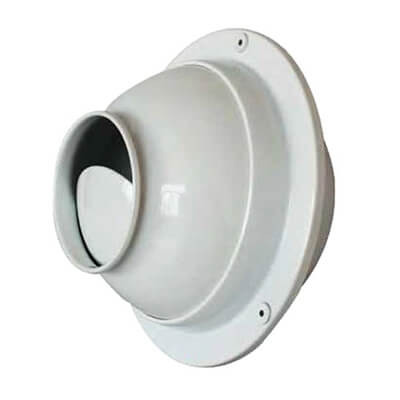 | 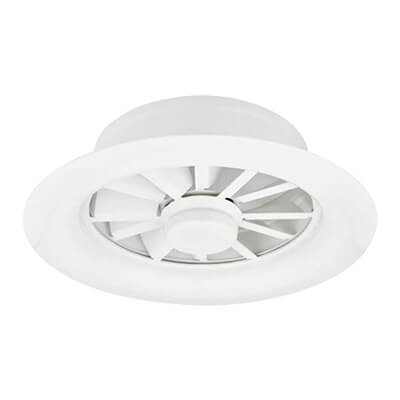 | 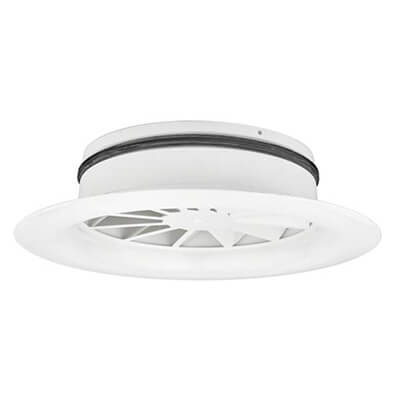 |
| Ball Jet Diffuser | Spot Jet Diffuser | Round Diffuser Adjustable Blades | Round Diffuser Fixed Blades |
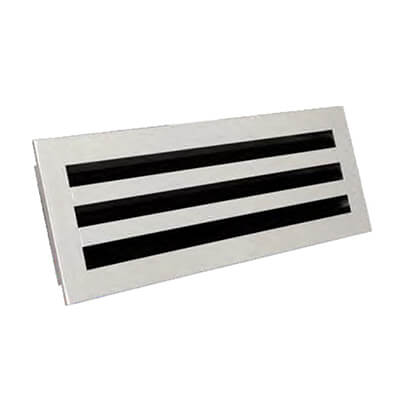 | 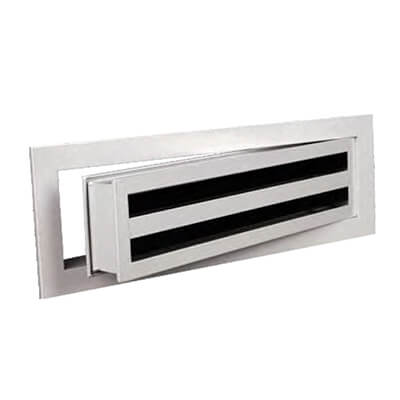 | 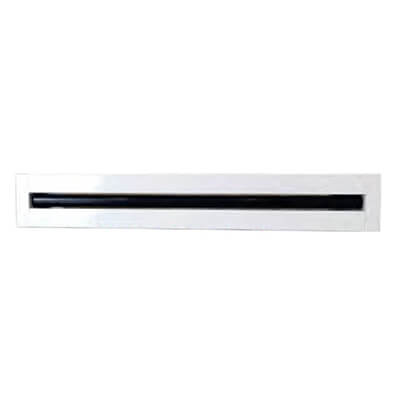 | 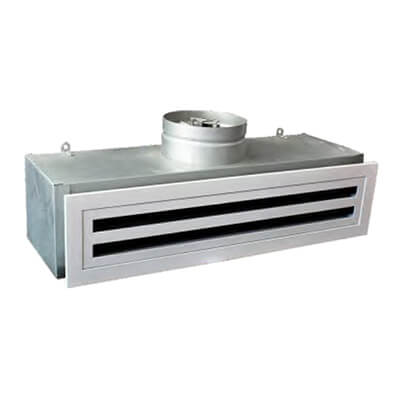 |
| Linear Slot Diffuser (LSD) | Linear Slot Diffuser Removable Core | Linear Slot Diffuser (LSD-ANR) | Linear Slot Diffuser Plenum Box |
Catalog of HVAC Linear Slot Diffusers
The Certifications and Accolades of AIREVERPEAK(Xingsheng):
- National Industrial Products Production License
- European Union CE Certification
- United States Market UL Certification
- ISO 9001 Quality Management System Certification
- ISO 14001 Environmental Management System Certification
- OHSAS 18000 Occupational Health and Safety Certification
- Energy Saving and Low Carbon Certification
- Mechanical and Electrical Equipment Installation Qualification II issued by the Ministry of Construction
- AAA Level Enterprise Recognition
- Jiangsu Famous Brand
- Top 100 Excellent Enterprises in China’s Refrigeration Industry
- Top Ten National Brands in China’s Refrigeration Industry
- Our Air Conditioner Terminal Products Rated as Top Ten Brands in China
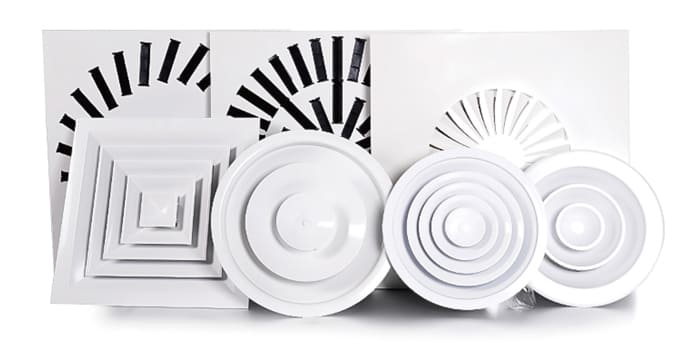
If you want to know more, please click below:
- HVAC Linear Slot Diffusers – The Ultimate Guide
- HVAC Egg Crate Diffuser – The Ultimate Guide
- HVAC Jet Nozzle Diffuser – The Ultimate Guide
- HVAC Linear Bar Grilles – The Ultimate Guide
- HVAC Air Swirl Diffusers – The Ultimate Guide
- HVAC Round Ceiling Diffusers – The Ultimate Guide
- Round Ceiling Diffusers – The Ultimate Guide
- HVAC Return Air Grille – The Ultimate Guide
- Exhaust Air Louver – The Ultimate Guide
- HVAC Registers – The Ultimate Guide
HVAC Air Ceiling Diffusers – The Ultimate Guide
1. What are HVAC ceiling diffusers and how do they work?
HVAC ceiling diffusers are components of a building’s heating, ventilation, and air conditioning (HVAC) system. Mounted on the ceiling, their main purpose is to distribute air that comes from the HVAC system into a room. They are designed to spread the air evenly across the space, ensuring that the temperature is consistent throughout the room. This even distribution helps in maintaining a comfortable indoor atmosphere. HVAC ceiling diffusers come in different shapes, but all serve the same basic function of efficiently circulating air in a room.
How They Work
- Air Distribution:
- Ceiling diffusers disperse air in specific patterns to optimize air circulation.
- They are engineered to spread the air in one or multiple directions, depending on the design.
- Regulating Airflow:
- Many diffusers are equipped with dampers or adjustable vanes that control the volume and direction of airflow.
- This allows for better control of room temperature and air distribution.
- Enhancing Comfort:
- By evenly distributing air, diffusers help maintain a consistent temperature throughout the space.
- They also reduce the velocity of the air entering the room, minimizing drafts and improving comfort.
Key Benefits
- Improved Air Quality: Effective dispersion of air helps in better ventilation, reducing the likelihood of stagnant air and contributing to improved indoor air quality.
- Energy Efficiency: Efficient air distribution means the HVAC system doesn’t have to work as hard to heat or cool a room, leading to energy savings.
- Aesthetic Integration: With various design options, ceiling diffusers can blend into the room’s decor, providing a functional yet unobtrusive presence.
2. What are the different types of HVAC ceiling diffusers available?
There are various types of HVAC ceiling diffusers available, each serving specific functional and aesthetic purposes. From standard square or rectangular to linear slot, circular, swirl, perforated, and directional diffusers, the selection can be tailored to suit the specific needs of a room or building.
Types of HVAC Ceiling Diffusers
- Standard Square or Rectangular Diffusers:
- These are common in both residential and commercial buildings.
- They typically have a simple design with multiple louvers or vanes to direct airflow.
- Linear Slot Diffusers:
- Feature long, narrow openings that provide a streamlined, architectural look.
- Ideal for modern interiors, they allow for directional air distribution along their length.
- Round or Circular Diffusers:
- These diffusers disperse air in a radial pattern, ideal for uniform air distribution in all directions.
- Often used in spaces where a more decorative appearance is desired.
- Swirl Diffusers:
- Designed to create a swirling, turbulent airflow, which allows for the rapid mixing of room and supply air.
- Effective in large or high-ceiling spaces, providing high induction rates and rapid temperature equalization.
- Perforated Diffusers:
- Have a faceplate with multiple small perforations for air distribution.
- Provide a gentle flow of air, making them suitable for environments where minimal draft is desired.
- Directional Diffusers:
- These are adjustable, allowing the airflow direction to be controlled and focused.
- Useful in areas where targeted air distribution is required.
Considerations in Choosing Ceiling Diffusers
- Airflow Requirements: The choice depends on the specific airflow needs of the space, such as volume, direction, and spread.
- Aesthetic Considerations: The style and appearance of the diffuser should complement the interior design of the room.
- Acoustic Performance: Some diffusers are designed to minimize noise, which is an important consideration in quiet environments.
- Energy Efficiency: The efficiency of air distribution can impact the overall energy consumption of the HVAC system.
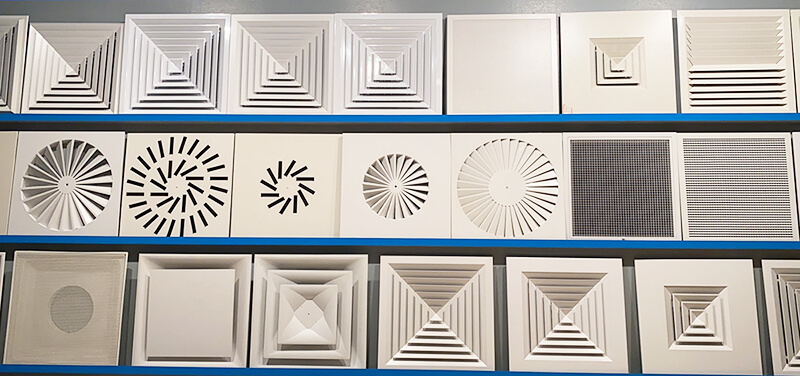
3. How do I choose the right size and type of diffuser for my space?
Choosing the right size and type of diffuser for your space depends on various factors such as room size, ceiling height, and aesthetic preferences.
Factors to Consider in Choosing the Right Diffuser
- Room Size and Volume:
- Measure the size of the room to determine the airflow requirements.
- Larger rooms may need bigger or multiple diffusers to ensure even air distribution.
- Ceiling Height:
- Higher ceilings may require diffusers that can project air more effectively over a larger distance.
- In rooms with low ceilings, choose diffusers that distribute air more evenly to avoid drafts.
- Airflow Patterns:
- Consider the desired airflow pattern (radial, linear, multi-directional) based on room layout and usage.
- For instance, linear slot diffusers might be more suitable for long, narrow spaces.
- Aesthetic Preferences:
- The style of the diffuser should complement the room’s interior design.
- There are various designs available, from discreet to decorative, to match different decor styles.
- Noise Level Considerations:
- Some diffusers are quieter than others, an important aspect in spaces like bedrooms or offices.
- Check the noise rating of the diffuser if the acoustic environment is a concern.
Tips for Choosing the Right Size and Type
- Consult HVAC Professionals:
- Seeking advice from HVAC experts can ensure that the diffuser choice aligns with your system’s capacity and the room’s needs.
- They can calculate the precise airflow requirements and recommend suitable options.
- Review Manufacturer Specifications:
- Look at the specifications provided by manufacturers, which usually include information on airflow capacity, noise level, and suitable applications.
- Compare different models and types to find the best fit for your space.
- Consider Future Needs:
- Think about any potential changes in room usage or layout that might affect HVAC needs.
- A flexible or adjustable diffuser might be a good choice if the space is subject to change.
Choosing the right size and type of diffuser for your space involves a careful assessment of the room’s dimensions, ceiling height, desired airflow patterns, aesthetics, and noise considerations. Consulting with HVAC professionals and reviewing manufacturer specifications are key steps in this process. By selecting the appropriate diffuser, you can ensure efficient air distribution, maintain a comfortable indoor environment, and complement the style of your space.
4. What are the benefits of using adjustable versus fixed ceiling diffusers?
The choice between adjustable and fixed ceiling diffusers depends largely on the specific needs of your space. Adjustable diffusers offer flexibility, customizable comfort, and adaptability, making them suitable for dynamic or multi-purpose spaces. Fixed diffusers, on the other hand, provide consistent air distribution, lower maintenance, cost-effectiveness, and aesthetic uniformity, making them ideal for spaces with a stable layout and design.
Benefits of Adjustable Ceiling Diffusers
- Flexibility in Airflow Direction:
- Adjustable diffusers allow you to change the direction of the air output to suit different room layouts or changing needs.
- Ideal for spaces where furniture layout or room usage might vary over time.
- Customizable Comfort:
- Users can adjust the airflow to address specific comfort requirements, such as reducing drafts or concentrating air in a particular area.
- This flexibility enhances the overall comfort level within the space.
- Adaptability to Seasonal Changes:
- The direction and strength of airflow can be modified according to seasonal variations, optimizing heating in winter and cooling in summer.
- Improved Air Circulation:
- By adjusting the diffuser, you can ensure better air circulation throughout the room, preventing issues like hot or cold spots.
Benefits of Fixed Ceiling Diffusers
- Consistency in Air Distribution:
- Fixed diffusers provide a consistent and uniform air distribution pattern, ideal for spaces with a stable layout.
- They are often designed to efficiently cover specific areas without the need for adjustment.
- Lower Maintenance:
- With fewer moving parts, fixed diffusers generally require less maintenance and are less prone to wear and tear.
- This makes them a reliable and hassle-free option in the long run.
- Simplicity and Cost-Effectiveness:
- Fixed diffusers are often simpler in design and can be more cost-effective to purchase and install.
- They are a practical choice for projects with budget constraints or where simplicity is desired.
- Aesthetic Uniformity:
- Fixed diffusers often offer a sleek and uniform appearance, which can be desirable in certain architectural settings.
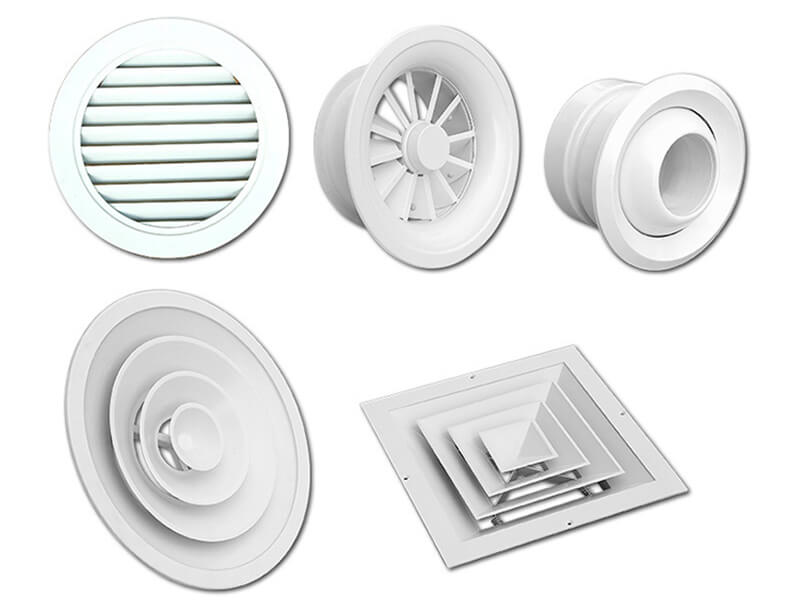
5. Can ceiling diffusers be used for both heating and cooling applications?
Yes, ceiling diffusers are versatile components in HVAC systems and can be effectively used for both heating and cooling applications. Their design allows them to adapt to different airflow requirements, making them suitable for various temperature control needs.
Ceiling Diffusers in Heating Applications
- Warm Air Distribution:
- In heating mode, ceiling diffusers help distribute warm air that naturally rises toward the ceiling.
- They can be adjusted (if adjustable) to direct the warm air downwards towards the occupants.
- Efficient Room Heating:
- By evenly dispersing warm air, diffusers contribute to a consistent temperature throughout the room.
- This uniform distribution helps in efficiently heating the space, reducing hot and cold spots.
Ceiling Diffusers in Cooling Applications
- Cool Air Dispersion:
- For cooling, ceiling diffusers take advantage of the fact that cool air falls.
- They distribute cool air evenly across the room, ensuring a comfortable environment during warmer months.
- Minimizing Drafts:
- Properly designed diffusers can minimize the feeling of cold drafts, which is often a concern with air conditioning.
- Adjusting the diffuser blades can help in controlling the airflow direction and intensity to prevent direct cold air streams.
Versatile and Adaptable Design
- Multi-Functional: Many modern ceiling diffusers are designed to work efficiently for both heating and cooling, adapting to the direction and type of airflow needed.
- Adjustable Options: Adjustable diffusers provide the added benefit of changing the airflow direction according to the season, optimizing for either heating or cooling.
Considerations for Maximum Efficiency
- Correct Sizing and Placement: To ensure effective heating and cooling, it’s important to choose the right size of the diffuser and place it strategically in the room.
- Regular Maintenance: Keeping the diffusers clean and well-maintained ensures they operate efficiently, regardless of the application.
Ceiling diffusers are capable of handling both heating and cooling applications in an HVAC system. Their ability to distribute air evenly and adapt to different airflow requirements makes them a versatile solution for year-round temperature control in indoor spaces. Proper selection, placement, and maintenance of these diffusers are key to maximizing their efficiency and effectiveness in both heating and cooling modes.
6. How do I install an HVAC ceiling diffuser?
Let’s take a look at a professional video first:
Installing an HVAC ceiling diffuser is a process that requires precision and careful planning to ensure it functions effectively. Whether you’re a DIY enthusiast or a professional, it’s important to follow the correct steps.
Steps for Installing an HVAC Ceiling Diffuser
- Preparation:
- Begin by selecting the right size and type of diffuser for your space, considering the room’s airflow requirements and aesthetics.
- Ensure that you have all the necessary tools, such as a ladder, screwdriver, tape measure, and possibly a drill.
- Location and Marking:
- Identify the ideal location for the diffuser on the ceiling. This should be based on the layout of the room and the HVAC system’s ductwork.
- Once the location is determined, use a tape measure and a marker to outline where the diffuser will be installed.
- Cutting the Opening:
- If there’s no pre-existing opening, you’ll need to cut one in the ceiling material. Ensure the size matches the dimensions of the diffuser.
- Use a saw appropriate for your ceiling material, being cautious to make a clean and precise cut.
- Attaching the Diffuser:
- If the diffuser has a backplate, secure it to the ceiling first.
- Then, fit the diffuser into the opening, making sure it’s flush with the ceiling surface.
- Use screws to firmly attach the diffuser to the backplate or directly to the ceiling, depending on the design.
- Securing and Sealing:
- Ensure the diffuser is securely fastened and doesn’t have any movement.
- For energy efficiency and to prevent air leaks, you may need to seal around the diffuser using a caulk or a similar sealing material.
- Final Checks:
- After installation, inspect the diffuser to ensure that it’s level and properly aligned.
- Check the operation of any adjustable vanes or dampers to ensure they move freely.
Important Considerations
- Safety First: Always prioritize safety, especially when working at heights or with power tools.
- Compatibility with Ductwork: Ensure that the diffuser is compatible with the existing ductwork in terms of size and airflow capacity.
- Professional Assistance: If you’re unsure about any step in the installation process, it’s advisable to seek assistance from a professional HVAC technician.
Installing an HVAC ceiling diffuser involves careful preparation, accurate measurement and cutting, secure attachment, and proper sealing. It’s important to ensure that the diffuser is compatible with your room and HVAC system for effective airflow management. While it can be a DIY project, don’t hesitate to consult a professional, especially for complex installations or when working with unfamiliar tools or materials.
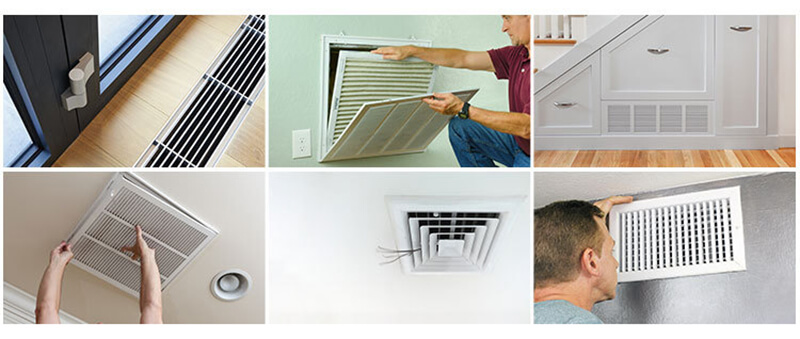
7. What are the maintenance requirements for HVAC ceiling diffusers?
Maintaining HVAC ceiling diffusers is essential for the efficient and effective operation of your heating, ventilation, and air conditioning system. Regular maintenance ensures that the diffusers function properly, contributing to optimal air distribution and indoor air quality.
Regular Cleaning
- Dust and Debris Removal:
- Dust and debris can accumulate on diffusers over time, potentially impeding airflow and diminishing air quality.
- Use a duster or vacuum with a soft brush attachment to gently clean the surface and vanes of the diffuser.
- Deep Cleaning:
- Periodically, a more thorough cleaning may be necessary, especially if there’s visible dirt or grime.
- Remove the diffuser from the ceiling, if possible, and clean it with mild soapy water. Avoid harsh chemicals that could damage the finish.
Inspection and Adjustments
- Checking for Damage:
- Inspect the diffuser for any signs of damage, such as cracks, dents, or rust, which could affect its performance.
- Damaged diffusers should be repaired or replaced to ensure efficient operation.
- Adjustment of Controls:
- If the diffuser has adjustable vanes or dampers, ensure they are moving freely and not stuck.
- Adjustments may be needed to optimize airflow based on seasonal changes or room usage.
Ensuring Proper Sealing
- Air Leak Check: Ensure that the diffuser is properly sealed to the ceiling to prevent air leaks, which can reduce HVAC efficiency.
- Sealant Application: If gaps or leaks are found, apply an appropriate sealant around the edges of the diffuser.
Professional Inspection
- Routine HVAC Check: As part of regular HVAC maintenance, have a professional inspect the diffusers to ensure they are part of a well-functioning system.
- System Balancing: Occasionally, it might be necessary to have the HVAC system balanced by a professional, which includes adjusting diffusers for optimal airflow.
Regular maintenance of HVAC ceiling diffusers, including cleaning, inspection, and proper sealing, is crucial for maintaining the efficiency and effectiveness of your HVAC system. Keeping up with these maintenance tasks will prolong the life of the diffusers and help maintain a comfortable and healthy indoor environment.
8. How does the design of a ceiling diffuser impact air distribution and comfort?
The design of a ceiling diffuser significantly impacts air distribution within a space and, consequently, the overall comfort level. Different designs cater to specific airflow patterns, room layouts, and aesthetic preferences, all of which play a role in creating a comfortable indoor environment.
Impact of Diffuser Design on Air Distribution
- Airflow Patterns:
- The design of the diffuser determines the pattern in which air is dispersed into a room, whether it’s a directional, radial, or multi-directional flow.
- This affects how evenly and effectively air circulates throughout the space, influencing temperature consistency and air quality.
- Throw and Spread:
- ‘Throw’ refers to how far air travels from the diffuser, and ‘spread’ indicates how wide the air disperses.
- The design of the diffuser affects both these aspects, impacting how well it can heat or cool a room, especially in spaces with high ceilings or large areas.
- Velocity Control:
- Ceiling diffusers are designed to control the velocity of the air as it enters a room.
- A well-designed diffuser will deliver air at a speed that is comfortable for occupants, avoiding drafts or hot spots.
Influence on Occupant Comfort
- Temperature Regulation:
- Effective diffuser design ensures consistent temperature distribution, reducing the likelihood of hot or cold spots.
- This is crucial for occupant comfort, especially in environments like offices or homes where people spend extended periods.
- Noise Level:
- The design can influence the noise level produced by the airflow. Quieter diffusers are preferable in environments where noise can be a disturbance, such as in bedrooms or meeting rooms.
- Aesthetic Integration:
- Beyond functionality, the aesthetic design of the diffuser also plays a role in occupant comfort.
- A diffuser that blends well with the ceiling and overall room design can contribute to a more pleasant and cohesive space.
The design of a ceiling diffuser has a profound impact on air distribution and, subsequently, the comfort level within a room. By influencing airflow patterns, throw and spread, and velocity, the diffuser design plays a key role in ensuring efficient temperature regulation, minimizing noise, and enhancing the overall aesthetic of a space.
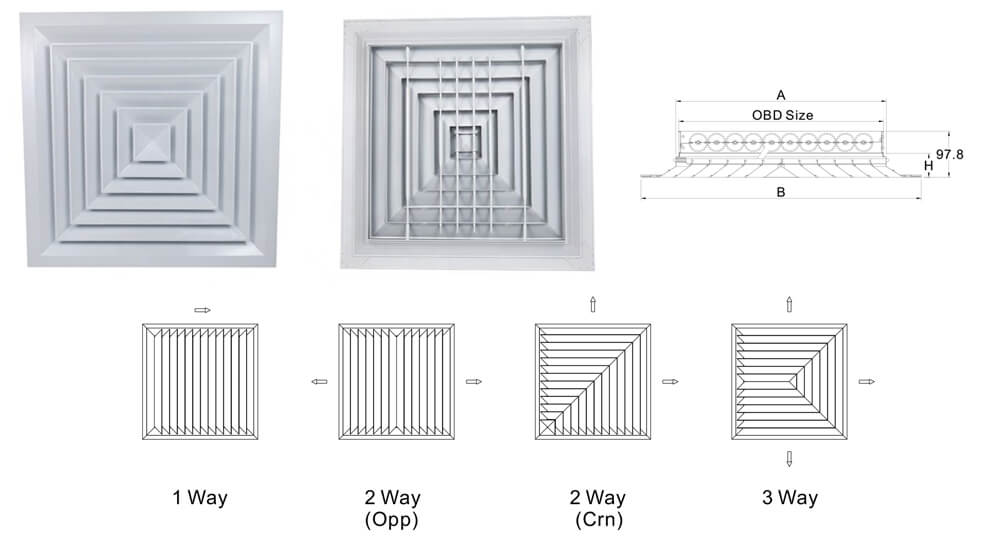
9. What materials are HVAC ceiling diffusers typically made from?
HVAC ceiling diffusers are manufactured from a variety of materials, each selected for its specific properties and suitability for different environments and applications. The choice of material impacts the diffuser’s durability, performance, and aesthetic appeal.
Common Materials for HVAC Ceiling Diffusers
- Aluminum:
- Widely used due to its lightweight and corrosion-resistant properties.
- Aluminum diffusers are durable and suitable for a range of environments, including those with moisture.
- Steel:
- Steel diffusers offer robustness and are often used in commercial and industrial settings.
- They can be coated or painted for additional corrosion resistance and aesthetic appeal.
- Plastic:
- Various high-quality plastics, such as ABS or polycarbonate, are used for their versatility and rust-proof qualities.
- Plastic diffusers are lightweight and can be molded into various shapes and sizes, offering more design flexibility.
- Fiberglass:
- Used in specific applications where lightweight and corrosion resistance are paramount.
- Fiberglass is less common but can be beneficial in certain corrosive environments.
Factors Influencing Material Choice
- Environmental Conditions: The presence of moisture, chemicals, or extreme temperatures can dictate the best material choice.
- Aesthetic Requirements: Material choice can influence the look of the diffuser. For example, aluminum and steel can be finished in various ways to match interior designs.
- Budget Constraints: The cost of materials can vary, with metals typically being more expensive than plastics.
- Durability and Longevity: For areas with high usage or susceptibility to damage, more durable materials like steel may be preferred.
The materials used for HVAC ceiling diffusers include aluminum, steel, various plastics, and occasionally fiberglass. Each material offers distinct benefits in terms of weight, durability, resistance to environmental factors, and aesthetics. The choice of material will depend on the specific requirements of the HVAC system, including environmental conditions, design preferences, budget, and the need for durability.
10. Are there energy-efficient options for HVAC ceiling diffusers?
Yes, there are energy-efficient options available for HVAC ceiling diffusers, which are designed to enhance the overall efficiency of heating, ventilation, and air conditioning systems. These energy-efficient diffusers focus on optimizing air distribution and reducing energy consumption.
Features of Energy-Efficient HVAC Ceiling Diffusers
- Improved Airflow Design:
- These diffusers are engineered to distribute air more evenly throughout a room, reducing the need for HVAC systems to work harder to maintain consistent temperatures.
- The design often includes features that enhance the throw and spread of air without increasing energy usage.
- Variable Air Volume (VAV) Diffusers:
- VAV diffusers can adjust the volume of air being distributed based on the room’s temperature requirements.
- They work in conjunction with HVAC controls to provide the necessary cooling or heating, optimizing energy usage.
- High Induction Diffusers:
- Designed to mix conditioned air with room air more efficiently, leading to faster temperature equalization.
- This can reduce the strain on HVAC units, especially in spaces with variable occupancy or usage.
- Thermal Diffusers:
- Some diffusers come equipped with thermal actuators that adjust the air volume automatically in response to room temperature changes.
- This automation enhances energy efficiency by reducing manual adjustments and over-conditioning.
Benefits of Energy-Efficient Diffusers
- Reduced Energy Bills: By optimizing air distribution and system performance, these diffusers can lead to significant energy savings.
- Enhanced Comfort: Uniform air distribution contributes to a more comfortable indoor environment, avoiding issues like hot or cold spots.
- Eco-Friendly: Improved energy efficiency means a lower carbon footprint, aligning with environmental sustainability goals.
Considerations for Selection
- Compatibility with HVAC System: Ensure the diffuser is compatible with your existing HVAC system, particularly if considering advanced options like VAV diffusers.
- Room Requirements: Consider the specific heating and cooling needs of the space, including size, ceiling height, and occupancy patterns.
- Professional Installation and Calibration: For optimal efficiency, it’s advisable to have these diffusers installed and calibrated by HVAC professionals.
Energy-efficient HVAC ceiling diffusers offer advanced features like improved airflow design, variable air volume control, high induction, and thermal responsiveness. These features contribute to reducing energy consumption, lowering operational costs, and enhancing indoor comfort.
Selecting the right energy-efficient diffuser requires considering the specific needs of your space and ensuring compatibility with your HVAC system. Professional installation and calibration are key to maximizing the benefits of these energy-efficient options.
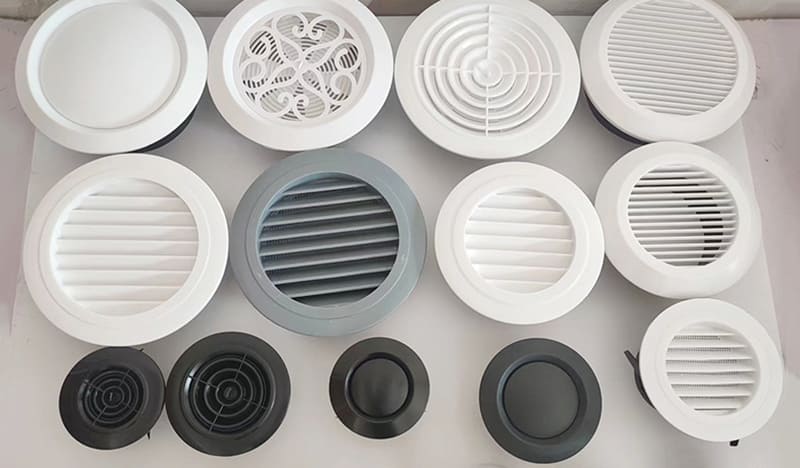
11. How do ceiling diffusers affect indoor air quality?
Ceiling diffusers significantly affect indoor air quality by ensuring efficient air distribution and circulation, which aids in temperature and humidity control, removes contaminants and reduces airborne pathogens. The positive impact of diffusers on air quality is maximized through proper placement, regular maintenance, and selecting the appropriate design and type for the specific needs of the space.
Influence of Ceiling Diffusers on Indoor Air Quality
- Air Distribution and Circulation:
- Ceiling diffusers are designed to disperse conditioned air (either heated or cooled) evenly throughout a room.
- Proper air distribution prevents stagnation and ensures that fresh air circulates effectively, which is crucial for maintaining good indoor air quality.
- Temperature and Humidity Control:
- By aiding in the efficient distribution of air, diffusers help maintain a consistent temperature and control humidity levels.
- Balanced temperature and humidity are important factors in preventing the growth of mold and mildew, which can degrade air quality.
- Removal of Contaminants:
- Effective air circulation facilitated by diffusers helps in removing airborne contaminants, such as dust, allergens, and pollutants.
- This is particularly important in spaces with limited natural ventilation.
- Reducing Airborne Pathogens:
- Good air circulation can also reduce the concentration of airborne pathogens, contributing to a healthier indoor environment.
- This aspect has become increasingly significant in public and shared spaces.
Factors That Enhance the Positive Impact
- Proper Placement and Sizing:
- The location and size of the diffuser should be appropriate for the space to ensure optimal air distribution.
- Incorrect placement or sizing can lead to uneven air flow and potential air quality issues.
- Regular Maintenance:
- Keeping ceiling diffusers clean and well-maintained is essential. Dust and debris accumulation on diffusers can hinder their performance and negatively affect air quality.
- Regular cleaning and inspection ensure that the diffusers function effectively.
- Design and Type of Diffuser:
- The specific design and type of diffuser impact how well it can distribute air. For example, diffusers with adjustable vanes can provide more targeted airflow.
- Choosing the right type of diffuser for a specific application is key to maintaining indoor air quality.
12. Can HVAC ceiling diffusers be integrated with smart home systems?
Yes, HVAC ceiling diffusers can be integrated with smart home systems, marking a significant advancement in home automation and HVAC technology. This integration enhances the functionality and convenience of managing indoor climate.
Integration of HVAC Ceiling Diffusers with Smart Home Systems
- Smart Diffusers:
- Modern ceiling diffusers are available with smart capabilities, allowing them to connect with home automation systems.
- These diffusers can be controlled remotely via apps or integrated with other smart home devices.
- Automated Airflow Control:
- Smart diffusers can automatically adjust airflow based on pre-set conditions or real-time environmental data.
- Integration with smart thermostats allows for seamless regulation of room temperature and air distribution.
- Compatibility with Home Automation Platforms:
- Many smart diffusers are designed to be compatible with popular home automation platforms like Google Home, Amazon Alexa, or Apple HomeKit.
- This allows for voice control and integration with other smart home routines.
Benefits of Smart HVAC Ceiling Diffusers
- Enhanced Comfort and Efficiency:
- Smart diffusers can optimize air distribution for individual room comfort, improving overall HVAC efficiency.
- They can respond to changes in room occupancy, temperature, or time of day, ensuring optimal comfort levels.
- Energy Savings:
- By regulating airflow more effectively, smart diffusers can contribute to reduced energy consumption.
- Smart systems can minimize HVAC operation when rooms are unoccupied, leading to energy savings.
- Convenience and Control:
- Users can control and adjust the settings of diffusers remotely, providing convenience and flexibility.
- The ability to program and automate settings contributes to a hassle-free experience.
- Data Insights and Monitoring:
- Integration with smart systems allows for the collection and analysis of data regarding air quality, temperature, and system performance.
- This data can be used to make informed adjustments for improved air quality and efficiency.
Considerations for Integration
- Compatibility: Ensure that the smart diffusers are compatible with your existing HVAC system and home automation platform.
- Professional Installation: It is advisable to have these systems installed and set up by professionals to ensure optimal functionality.
- Cost Implications: Smart diffusers and their integration with home systems can involve higher initial costs, but they can offer long-term savings and convenience.
The integration of HVAC ceiling diffusers with smart home systems represents a significant leap forward in home automation and climate control technology. Smart diffusers provide enhanced comfort, energy efficiency, convenience, and valuable insights into indoor climate conditions. While considering such an integration, it’s important to assess compatibility, seek professional assistance for installation, and consider the long-term benefits against the initial investment.
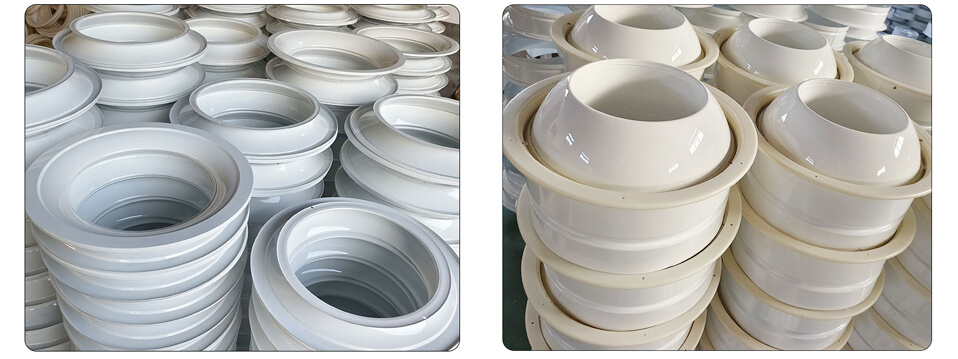
13. What is the lifespan of an HVAC ceiling diffuser?
The lifespan of an HVAC ceiling diffuser depends on several factors, including the material quality, the environmental conditions it’s exposed to, and how well it’s maintained. Generally, ceiling diffusers are designed for long-term use, offering substantial service life under normal conditions.
Factors Influencing the Lifespan of Ceiling Diffusers
- Material Quality:
- Diffusers made from high-grade materials like heavy-duty aluminum, steel, or robust plastics tend to have a longer lifespan.
- The material’s resistance to factors like corrosion, moisture, and general wear plays a significant role.
- Environmental Exposure:
- Diffusers installed in environments with high humidity, fluctuating temperatures, or corrosive atmospheres may experience reduced longevity.
- Indoor diffusers typically last longer than those in harsher external environments.
- Usage and Handling:
- The frequency and manner of use can impact the lifespan. For instance, diffusers in high-traffic areas or those frequently adjusted may wear out faster.
- Proper handling and minimal adjustments can extend their functional life.
Typical Lifespan Estimates
- Metal Diffusers: Quality metal diffusers, especially those made from aluminum or steel, can last anywhere from 15 to 25 years, sometimes even longer with proper care.
- Plastic Diffusers: While generally less durable than metal, high-quality plastic diffusers can offer a lifespan of 10 to 15 years.
- Specialized Diffusers: Those with additional features, like smart technology or specific design enhancements for harsh environments, might have varying lifespans based on their components and construction.
Maintenance for Longevity
- Regular Cleaning: Accumulation of dust and debris can lead to reduced efficiency and potentially shorten the lifespan. Regular cleaning is essential.
- Inspection and Repairs: Periodic checks for any signs of damage, wear, or malfunctioning parts can help in timely repairs, extending their useful life.
- Professional Maintenance: Occasionally, having a professional HVAC technician inspect and maintain the diffusers can ensure they are functioning optimally.
The lifespan of an HVAC ceiling diffuser can vary, but with quality materials and regular maintenance, it can serve effectively for many years. Metal diffusers typically offer the longest lifespan, while plastic ones are a bit less durable but still provide substantial service under normal conditions. Regular cleaning, careful handling, and periodic professional check-ups are key to maximizing the longevity and performance of ceiling diffusers.
14. How do I calculate the airflow requirements for my space?
Calculating the airflow requirements for your space is a critical step in ensuring that your HVAC system operates efficiently and effectively. The correct airflow calculation takes into account various factors such as room size, usage, and specific heating or cooling needs.
Basic Steps to Calculate Airflow Requirements
- Determine the Room’s Volume:
- Measure the length, width, and height of the room to calculate its total volume.
- Use the formula: Volume = Length x Width x Height.
- Understand Air Changes per Hour (ACH):
- ACH refers to the number of times the air within a space needs to be replaced each hour.
- The required ACH varies depending on the room’s use (e.g., living spaces, kitchens, bathrooms, and commercial spaces have different ACH standards).
- Calculate the Required Airflow:
- Multiply the room volume by the ACH to determine the cubic feet per hour (CFH) of air required.
- Use the formula: Required Airflow (CFH) = Room Volume x ACH.
Factors Affecting Airflow Calculation
- Room Usage and Occupancy:
- Different activities and occupancy levels affect the amount of ventilation needed.
- Rooms with higher occupancy or activities that generate more pollutants (like kitchens or workshops) require higher ACH.
- Local Climate and Building Insulation:
- Consider the local climate, as this affects heating and cooling loads.
- Well-insulated rooms may require less airflow compared to poorly insulated ones.
- Existing HVAC System Capabilities:
- Consider the capacity of your current HVAC system.
- Ensure that the system can meet the calculated airflow requirements without being overworked.
Calculating the airflow requirements for a room involves determining the room’s volume, understanding the needed air changes per hour, and considering factors like room use, occupancy, local climate, and building insulation. While basic calculations can be done using simple formulas, for more complex needs or precise calculations, consulting with an HVAC professional is advisable.
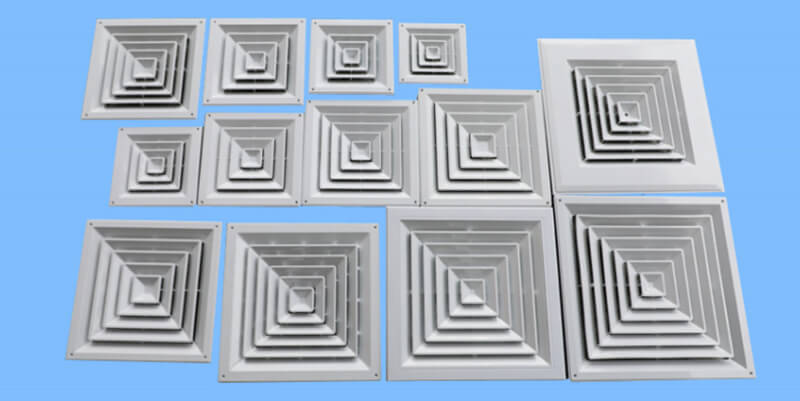
15. What are the noise levels associated with different ceiling diffusers?
The noise levels of ceiling diffusers in HVAC systems depend on their design, airflow velocity, and installation quality. Different types of diffusers, such as standard, linear slot, perforated, and swirl diffusers, have varying noise levels.
Factors Influencing Noise Levels in Ceiling Diffusers
- Design and Construction:
- The physical design of the diffuser, including the shape and size of its blades or vanes, can influence noise levels. Some designs are more aerodynamic and reduce noise.
- Materials used also play a role; some may dampen sound better than others.
- Airflow Velocity:
- Higher airflow velocities generally result in higher noise levels.
- Diffusers designed to operate effectively at lower velocities can help reduce noise.
- Installation Quality:
- Improper installation can lead to increased noise due to factors like loose parts or inadequate sealing.
- Correct and professional installation is key to minimizing operational noise.
Noise Levels of Different Ceiling Diffusers
- Standard Square or Rectangular Diffusers:
- These common diffusers can vary in noise level depending on design and airflow.
- Generally, they produce a moderate level of noise, noticeable but not usually disruptive.
- Linear Slot Diffusers:
- Often quieter than standard designs, as they allow air to flow smoothly and at a lower velocity.
- Preferred in settings where noise minimization is important, such as offices or bedrooms.
- Perforated Diffusers:
- These can be very quiet, as the multiple small openings disperse air gently.
- Ideal for applications requiring minimal noise distraction.
- Swirl and High-Induction Diffusers:
- Can produce more noise due to the turbulent air patterns they create.
- Best suited for high-ceiling or larger areas where the noise can disperse without causing discomfort.
Assessing and Mitigating Noise
- Noise Ratings: When selecting a diffuser, check its Noise Criteria (NC) rating, which indicates the expected noise level during operation.
- Consider Room Use: Choose diffusers with appropriate noise levels for the room’s purpose. For instance, low-noise diffusers are better for bedrooms and study areas.
- Professional Advice: Consult with HVAC professionals for recommendations on diffusers that balance airflow needs with acceptable noise levels.
16. How do HVAC ceiling diffusers compare to wall or floor registers?
Ceiling diffusers, wall registers, and floor registers each offer unique benefits in terms of air distribution, aesthetic appeal, and practicality. The choice between them depends on the specific heating and cooling needs, room layout, accessibility for maintenance, and interior design preferences.
Ceiling Diffusers
- Air Distribution: Designed to distribute air evenly across a room from above. Ideal for cooling applications as cool air falls naturally.
- Aesthetic Appeal: Often more discreet, blending seamlessly into the ceiling. Offers various design options to match interior decor.
- Placement: Suitable for rooms with limited wall or floor space.
- Maintenance: Cleaning and maintenance may require a ladder or special tools due to height.
Wall Registers
- Air Distribution: Effective for both heating and cooling. In heating applications, wall registers allow warm air to rise naturally into the room.
- Space Utilization: Ideal for rooms where ceiling or floor placement is not practical. Good for targeted airflow distribution.
- Accessibility: Easier to access for maintenance and adjustment compared to ceiling diffusers.
- Design Options: Available in various styles and finishes to complement wall decor.
Floor Registers
- Air Distribution: Primarily used for heating as warm air rises from the floor level. Can be less effective for cooling due to stratification issues.
- Installation: Commonly found in homes with ductwork running beneath the floors.
- Accessibility: Easily accessible for cleaning and maintenance. However, placement can be an issue in high-traffic areas.
- Considerations: Require careful placement to avoid being covered by furniture or obstructed by curtains.
Key Comparison Points
- Efficiency in Heating/Cooling: Ceiling diffusers are generally more efficient for cooling, while floor registers are better suited for heating.
- Room Layout and Design: The choice may depend on the structural layout of the space and aesthetic considerations.
- Ease of Access: Wall and floor registers are more accessible for adjustments and cleaning compared to ceiling diffusers.
- Airflow Control: Ceiling diffusers offer even distribution of air, while wall and floor registers can provide more direct airflow control.
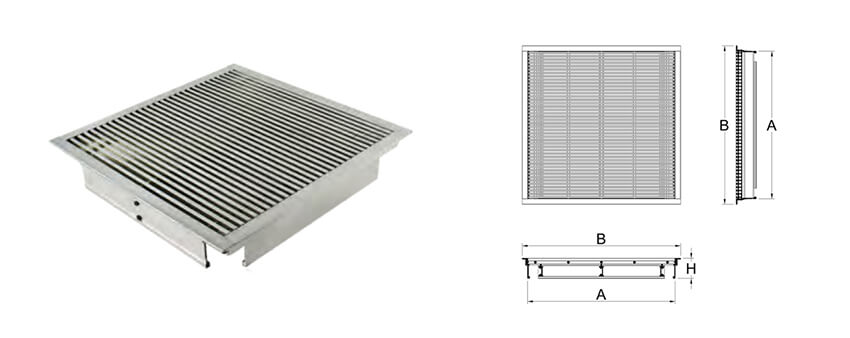
17. What factors affect the pricing of HVAC ceiling diffusers?
The pricing of HVAC ceiling diffusers is influenced by material quality, size and design complexity, functional features, aesthetic considerations, brand reputation, installation requirements, and market factors. When selecting a ceiling diffuser, it’s important to consider these factors in relation to your specific needs and budget, ensuring that you choose a product that offers the best balance of price, functionality, and quality.
Material Quality and Type
- Materials Used: Diffusers made from high-grade materials like aluminum or steel typically cost more than those made from plastic or fiberglass.
- Durability: Higher-priced materials usually offer greater durability and longevity, which can be cost-effective in the long run.
Size and Design Complexity
- Size: Larger diffusers or those with complex shapes and designs often cost more due to the increased material and manufacturing efforts.
- Customization: Customized or specially designed diffusers to fit unique spaces or aesthetic requirements can also increase the price.
Functional Features
- Adjustability: Diffusers with adjustable louvers or vanes for directing airflow can be more expensive than fixed models.
- Additional Functionalities: Features like integrated dampers for airflow control or sound attenuation materials for noise reduction can add to the cost.
Aesthetic Considerations
- Finish and Style: A premium finish or a design that complements specific interior decor can increase the price.
- Architectural Integration: Diffusers designed to blend seamlessly with architectural features may come at a higher price point.
Brand and Quality
- Brand Reputation: Products from well-known brands or manufacturers with a reputation for quality may be priced higher.
- Quality Assurance: Diffusers that come with longer warranties or quality certifications can also carry a higher price tag.
Installation and Compatibility
- Ease of Installation: Designs that are easy to install may be more cost-effective when considering installation expenses.
- System Compatibility: The need for compatibility with existing HVAC systems can also influence the price, especially if specific designs or modifications are required.
Market Factors
- Supply and Demand: Market trends and availability can affect pricing. For instance, popular or in-demand models may be priced higher.
- Regional Variations: Prices can vary regionally due to factors like shipping costs or local market conditions.
18. Are there customizable options for ceiling diffusers (color, shape, size)?
Yes, there are customizable options available for ceiling diffusers in terms of color, shape, and size, allowing them to better fit the specific requirements and aesthetics of different spaces. Customization in HVAC products is increasingly sought after for both functional and aesthetic reasons.
Customization in Color
- Color Matching: Ceiling diffusers can be customized to match the color scheme of the room. This includes standard colors or specific shades to blend with or complement the interior design.
- Finishes: Various finishes (matte, glossy, textured) can also be chosen to align with the room’s décor.
Customization in Shape
- Variety of Shapes: Beyond the standard square or circular shapes, manufacturers can offer diffusers in unique shapes to fit specific design needs.
- Architectural Integration: Custom shapes can be designed to integrate seamlessly with unique architectural features.
Customization in Size
- Size Adaptability: Ceiling diffusers can be customized in size to fit different room sizes and air distribution requirements.
- Specific Ventilation Needs: Custom sizes are particularly useful in accommodating unique ventilation needs or fitting into non-standard spaces.
Additional Customizable Features
- Adjustable Louvers or Vanes: For specific airflow direction control, diffusers can have customizable louvers or vanes.
- Integrated Lighting or Additional Functions: Some diffusers can also be customized to include integrated lighting or other functionalities for a multifunctional ceiling solution.
Considerations for Custom Ceiling Diffusers
- Cost Implications: Customization often comes at a higher price compared to standard models, due to the additional manufacturing and design work involved.
- Lead Time: Custom orders may have longer lead times, as they require specific production processes.
- Professional Consultation: For complex customizations, consulting with HVAC professionals or interior designers can ensure that the diffuser meets both functional and aesthetic requirements effectively.
Customizable options for ceiling diffusers in terms of color, shape, and size offer enhanced flexibility to meet specific design and functional needs of a space. These options allow for a more tailored approach to HVAC system design, aligning with the interior aesthetics and specific air distribution requirements. While customization provides these advantages, it’s important to consider factors like cost, production time, and the need for professional guidance to make the most of these personalized options.
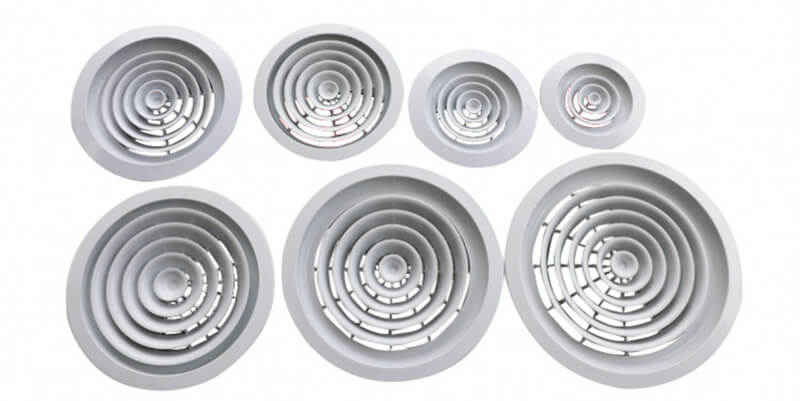
19. How can I troubleshoot common issues with ceiling diffusers?
Troubleshooting common issues with ceiling diffusers often involves checking for blockages, adjusting vanes for optimal airflow, tightening loose components, and maintaining cleanliness. Understanding these basic troubleshooting steps can help in quickly resolving common problems.
Common Issues and Troubleshooting Steps
- Insufficient Airflow:
- Check for Blockages: Ensure that the diffuser is not blocked by dust, debris, or furniture.
- Inspect Ductwork: Look for any disconnections or leaks in the ductwork leading to the diffuser.
- Air Filter Check: A clogged air filter can restrict airflow. Check and replace it if necessary.
- Uneven Air Distribution:
- Adjust the Vanes: If the diffuser has adjustable vanes, try repositioning them for better air distribution.
- Room Layout Consideration: Sometimes, rearranging the room layout can help improve airflow distribution.
- Excessive Noise:
- Tighten Loose Parts: Noise can be due to loose parts in the diffuser. Tighten any screws or fastenings.
- Check for Duct Issues: Noise can also originate from issues in the ducts, such as obstructions or pressure problems.
- Draughts or Discomfort:
- Repositioning Vanes: Redirect the airflow away from directly blowing onto occupants.
- Consider a Diffuser Replacement: In some cases, replacing the diffuser with one that has a different airflow pattern can resolve the issue.
- Dust or Debris Emission:
- Clean the Diffuser: Regularly clean the diffuser to remove any accumulated dust.
- Inspect the Ducts: Excessive dust can also indicate a problem in the ducts, like leaks or insulation issues.
Preventative Measures and Maintenance
- Regular Cleaning: Keep the diffuser and surrounding area clean to prevent blockages and maintain air quality.
- Routine Inspections: Regularly inspect the diffuser and connected ductwork for any signs of wear or damage.
- Professional Maintenance: For persistent or complex issues, seek assistance from an HVAC professional. They can conduct a thorough inspection and provide solutions.
20. What are the latest innovations in HVAC ceiling diffuser technology?
The HVAC industry continuously evolves, with innovations aimed at increasing efficiency, enhancing comfort, and integrating smart technology. These advancements are also reflected in the latest innovations in HVAC ceiling diffuser technology.
Smart Diffusers
- Integration with Smart Home Systems: Modern diffusers can be integrated with smart home systems, allowing for remote control and automation.
- Sensor-Based Operation: Some smart diffusers come equipped with sensors to detect room occupancy, adjusting airflow automatically for optimal comfort and efficiency.
Improved Air Quality Management
- Air Purifying Technologies: Newer models of diffusers are being integrated with air purification systems that can filter and cleanse the air as it circulates, enhancing indoor air quality.
- CO2 Level Monitoring: Advanced diffusers can monitor carbon dioxide levels, contributing to better air quality management in enclosed spaces.
Energy Efficiency
- High-Efficiency Designs: The latest diffusers are designed for maximum energy efficiency, reducing the overall energy consumption of HVAC systems.
- Variable Air Volume (VAV) Control: Some diffusers now come with VAV capabilities, adjusting the volume of air dispersed based on the room’s current temperature and occupancy levels.
Enhanced Aesthetic Appeal
- Customizable Designs: There’s an increasing focus on the aesthetic appeal of diffusers, with customizable colors, shapes, and sizes to blend seamlessly with interior designs.
- Low-Profile and Architectural Integration: New designs include low-profile diffusers that are less obtrusive and others that integrate architecturally with the ceiling for a more cohesive look.
Noise Reduction Technologies
- Quiet Operation Designs: Innovations in design and materials have led to diffusers that operate much more quietly, an important consideration in residential and commercial spaces.
- Acoustic Dampening Features: Some diffusers now include materials and design elements specifically aimed at reducing noise for a more comfortable environment.
Environmental Impact
- Eco-Friendly Materials: The use of sustainable, recyclable materials in diffuser manufacturing is becoming more common, aligning with environmental sustainability goals.
- Energy Conservation Features: Innovations are also focused on reducing the carbon footprint of HVAC systems through more efficient air distribution.
The latest innovations in HVAC ceiling diffuser technology encompass smart home integration, improved air quality management, energy efficiency, enhanced aesthetics, noise reduction, and environmental sustainability. These advancements not only improve the functionality and efficiency of HVAC systems but also enhance user comfort and contribute to a healthier indoor environment.

Need High-quality HVAC Grilles and Diffusers? Shoot us a message, and I’ll be happy to assist you in picking the right grilles or diffusers for your needs.

